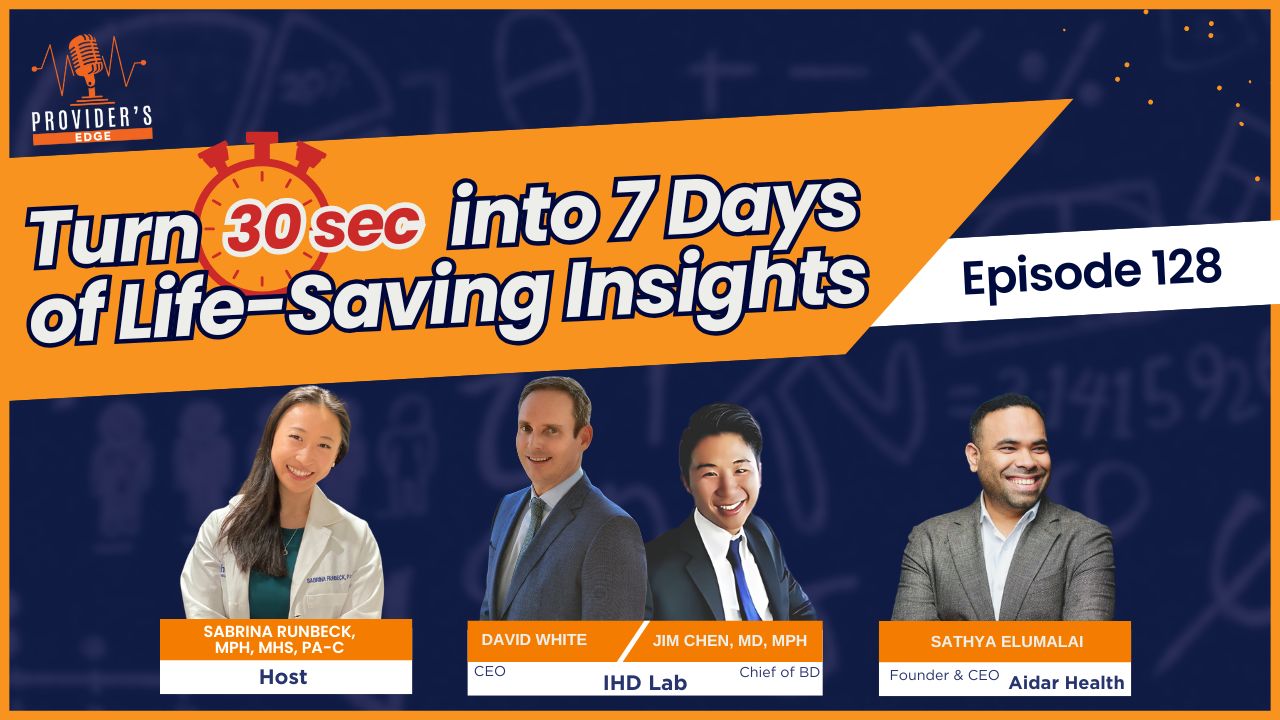
The Hidden Metrics Killing Your HealthTech Company:
What Successful $5M+ Founders Track Daily?
"Here's a shocking truth that killed a $5M healthcare tech startup last month - and 72% of funded companies are making the same mistake right now."
I watched it happen in slow motion.A healthcare tech company with everything going for them - millions of dollars in funding, brilliant developers, and groundbreaking technology - imploded in just 90 days. Not because of competition. Not because of market conditions. But because they were tracking the wrong numbers.
Table of Contents
Listen anywhere you get your podcastin' on.
Live Interview

The Million-Dollar Metric Mistake
Last week, I witnessed something that haunts every healthcare tech investor's nightmares.
Picture this: A sleek boardroom in a well-funded healthcare tech company. Champagne bottles popping. The leadership team celebrating their 50th feature launch this quarter. Success seemed to radiate from every corner.
Then I glanced at their dashboard.
User retention: Down 15%. Technical support tickets: Doubled. Patient outcome improvements: Unknown.
This wasn't just another startup stumble. This was a $5M-funded company hemorrhaging value while celebrating speed. Their story represents a critical warning for every healthcare tech founder pushing for growth.
Why Traditional Metrics Fail Healthcare Tech Companies
When we look at successful healthcare tech companies scaling beyond $5M, a clear pattern emerges. The winners aren't those shipping the most features or raising the most money. They're the ones measuring what truly matters in healthcare innovation.
The True Cost of Wrong Metrics
- Lost talent (average replacement cost: $65,000 per developer)
- Decreased customer retention (can reduce company value by 30-50%)
- Wasted development resources (average: $120,000 per misaligned feature)
- Missed market opportunities (estimated impact: $2M+ annually)
Three Real Stories of Metric Mishaps
1. The Tale of the Burning Bridge
A brilliant CTO watched helplessly as her top developers resigned one after another. Despite competitive salaries and exciting projects, something was fundamentally broken.
The root cause? They were building features at breakneck speed but had no way to measure their impact on patient care. As one departing developer put it, "We're just throwing code into a black hole."
The Solution: Impact-Focused Metrics
We implemented three key measurements:
- Patient engagement rates per feature
- Clinical workflow improvement scores
- Direct revenue impact tracking
Results after 3 months:
- Developer retention improved by 85%
- Feature adoption rates doubled
- Team satisfaction scores increased by 40%
2. The Revenue Mirage
A founder celebrated hitting $5M in revenue, unaware that their profit margins were vanishing. Their fatal flaw? Tracking top-line growth while ignoring efficiency metrics.
Key issues discovered:
- Customer acquisition costs: $2,000 → $8,000
- Implementation timelines: 2 weeks → 3 months
- Support costs consuming 40% of revenue
The Health Trinity Framework Implementation
We introduced what I call the "Health Trinity":
- Acquisition efficiency
- Implementation speed
- Support sustainability
Results after 6 months:
- Acquisition costs reduced by 60%
- Implementation time cut to 3 weeks
- Support costs lowered to 15% of revenue
- Profit margins improved by 300%
3. The Integration Insight
A promising healthcare app struggled with hospital adoption despite strong initial sales. Their critical error? Measuring implementation completion instead of implementation success.
The Clinical Impact Framework
We developed a comprehensive measurement system:
Provider Adoption Velocity
- Daily active users
- Feature utilization rates
- User engagement patterns
Workflow Integration Scores
- Time saved per procedure
- Error reduction rates
- Process improvement metrics
Time-to-Value Measurements
- Days to first successful use
- Speed to ROI achievement
- Training completion rates
Patient Outcome Improvements
- Clinical outcome metrics
- Patient satisfaction scores
- Care quality indicators
Staff Satisfaction Metrics
- User satisfaction ratings
- Feature request fulfillment
- Support ticket resolution times
Results after implementation:
- Hospital adoption rates: +200%
- User satisfaction scores: 6.5 → 9.2
- Contract renewal rates: 95%
The Framework for Meaningful Metrics
Based on these experiences, we've developed a comprehensive framework for healthcare tech companies to ensure their metrics drive real value.
1. Patient Impact North Star
- Define clear outcome metrics
- Link features to patient care improvements
- Measure long-term health impacts
2. Revenue Reality Check
- Track customer acquisition efficiency
- Monitor implementation success rates
- Measure support sustainability
- Analyze margin protection
3. Team Engagement Dashboard
- Feature impact visibility
- Clinical workflow improvements
- Patient outcome connections
- Revenue contribution clarity
Implementation Steps
Audit Current Metrics
- Identify gaps in measurement
- Evaluate metric relevance
- Assess data collection methods
Define Key Performance Indicators
- Set baseline measurements
- Establish growth targets
- Create monitoring schedules
Build Measurement Infrastructure
- Implement tracking tools
- Design reporting dashboards
- Train team members
Regular Review and Adjustment
- Weekly metric reviews
- Monthly trend analysis
- Quarterly strategy alignment
FAQ: Common Metric Tracking Questions
Q: How many metrics should we track? A: Focus on 5-7 key metrics that directly align with patient outcomes, revenue growth, and team engagement.
Q: How often should we review metrics? A: Daily for operational metrics, weekly for team metrics, and monthly for strategic metrics.
Q: What's the most important metric to start with? A: Begin with your Patient Impact North Star - the one metric that best captures your contribution to improved healthcare outcomes.
Taking Action: Next Steps
- Identify your current metric gaps
- Define your Patient Impact North Star
- Implement the Health Trinity framework
- Create your team engagement dashboard
- Establish regular review cycles
__________________________________________________________________________________________________________
Remember, in healthcare tech, hope is not a strategy. Metrics matter not because they're numbers, but because they're narratives. They tell the story of your impact, guide your team's efforts, and ultimately determine your success.
? Ready to assess your company's impact and identify areas for growth? Take our Impact Quotient Quiz now: PulsePointPath.com/Quiz
__________________________________________________________________________
About the author: Sabrina Runbeck, MPH, MHS, PA-C, empowers healthcare innovators to streamline their businesses so they can scale effortlessly---even while taking a 4-week vacation. A former Cardiothoracic Surgery Physician Associate, she co-founded PulsePoint Path, working with an advisory board to help founders amplify their social impact and profits. A bestselling author and sought-after speaker, Sabrina hosts the "Provider's Edge" and "HealthTech Growth" podcasts, while leading Healthcare Amplified, a network focused on boosting visibility and relationships for innovative healthcare leaders.
Recommended Podcast Episodes
I never expected hospital tech adoption to be this controversial, but my conversations at ViVE just...
The FDA has approved over 700 AI-enabled medical devices, yet many healthcare professionals remain wary of their safety and effectiveness.
Be a guest on our show
The Provider's Edge show is always looking to feature healthcare change-makers and celebrate the work they are doing to improve healthcare.
Together, we can encourage other healthcare entrepreneurs and startup founders to up-level their businesses.If you or someone you know could be a good fit as a guest on the show, please click on the bottom below to apply as a speaker.
Healthcare Entrepreneurs!
I can help you gain visibility and credibility in the right circles so you can accelerate your mission and profitability!After overcoming burnout working in surgery, I went back to my roots in neuroscience and public health. I learned the importance of building key human relationships with my team throughout our organization.While helping healthcare executives and entrepreneurs to get out of the day-to-day operation of their practice, I realized I needed more visibility and more connections to reach my ideal clients.Once I set out to be highly visible in the right circles, I was able to leverage my network of strategic partners to convert clients 5x higher than any other marketing channel I had tried previously.Now I help healthcare change-makers to accelerate their impact and increase profitability by gaining visibility and credibility with the right strategic partners.My clients no longer worry about where their next client is coming from, the need to plan additional budget for ads spending, or losing the ability to connect with others because their social media account is shut down.If you want to share your social mission with the world and gain pivotal supporters that become loyal clients... then you are in the right place, with the right consultant who is also a recovered clinician.




